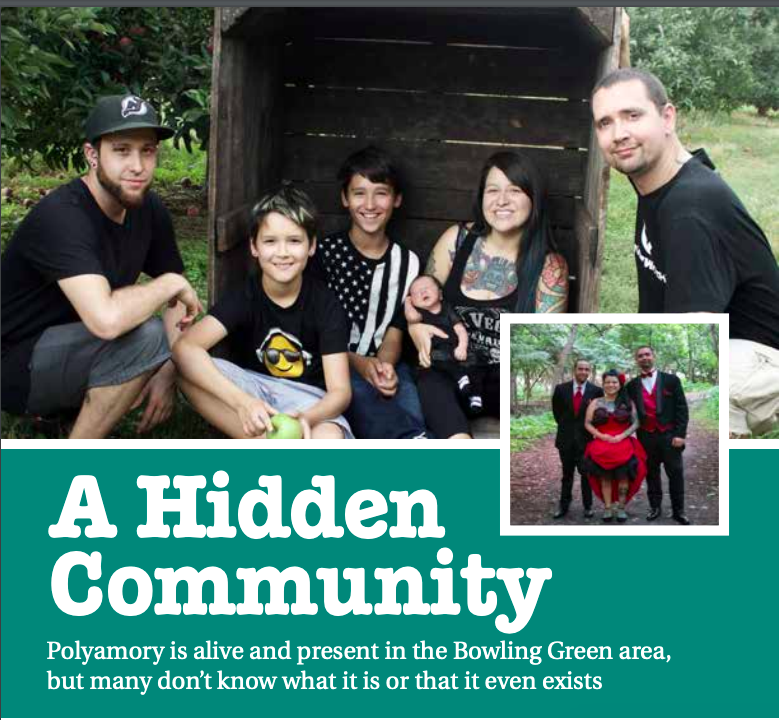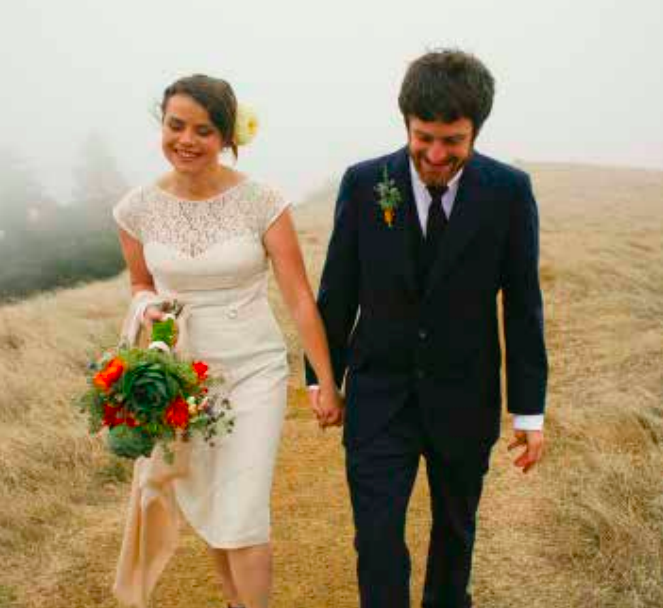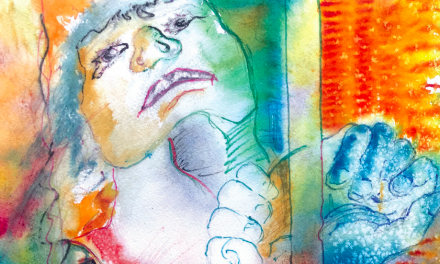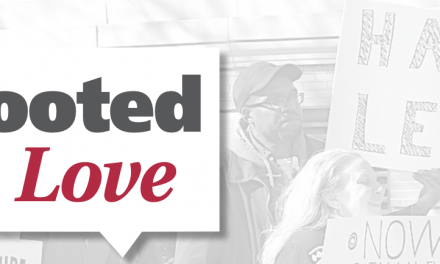
By Holly Shively | Spring 2018
Heather Ware has been dating her boyfriend since she was 18 years old. After roughly three and a half years together, they found a way to avoid missing out on anything, but not in the way many would expect.
Ware’s boyfriend always felt a little bad that the two of them started dating so young, depriving Ware, a 22-year-old senior, of experiencing other romantic
partners. The two found a solution in polyamory—a relationship style rooting in the idea of having many loves, where a person can be in love with or in committed relationships with more than one person at a time.
It all began on a date when the two started talking about not wanting to waste their youth since they were “only going to be young and hot once,” Ware said. From there, the couple began an open relationship in June, which developed into a fully polyamorous relationship
after more discussion. Over the course of their relationships, they had to work out some kinks. “At first we had a veto rule in place, which is kind of toxic,” Ware said.
“It’s disrespectful to the other person.” With the veto, Ware and her boyfriend could prevent each other from getting involved with someone else if they weren’t comfortable with that specific person; however, they realized it went against the respect those in polyamorous relationships pride themselves on.
” Only going to be young and hot once “
— Heather Ware
BGSU Senior
THE ‘POLY PATH’
That’s the beauty of polyamory to Anya Light, a former practitioner and current researcher and advocate of the relationship style—partners learn that they do not own each other, and communication becomes key. “This poly path is a lot about emotional literacy,” Light said.
“Poly people tend to be able to communicate about their feelings more readily and available than not.” This communication roots in having to deal with jealousy, so difficult conversations become the norm.
While those within the poly community may be able to bring up difficult topics, the topic of polyamory itself makes many people uncomfortable, especially in the Bowling Green community.
“It is a deeply healing practice to begin to view yourself as capable of loving many people in different ways,” Light said.
The poly path breaks down the rules of the very limited beliefs of how humans should act, Light said, and the poly community generally is more in tune with knowing how to get their needs met.
“A lot of people think the only way to get those needs met are through a romantic partner and only one of them,” she said. But Light said poly people understand that being snuggly and cozy with different kinds of people can be friendly rather than sexual.
Alexia Shrout of Maumee first dabbled in polyamory in high school where she and her now-husband had a few girlfriends.
Now she is in a closed poly family with that husband who she has been with for 15 years, her second husband of seven years (through a spiritual ceremony), and their three children. Shrout also notices that people outside of the poly community automatically sexualize it.
“One of the first questions I get asked is ‘how does the sex work,’” she said. “I’m not even exaggerating.” Similarly, 31-year-old Chris Kasior constantly attempts to re-educate people about the concept of sex within the polyamorous community.
“There’s people in the community that are in it for the sex, but not all of them,” Kasior said. “It’s a gross generalization. There are asexuals, and demisexuals within polyamory. Even among sexpositive community members there are dynamics that are just platonic, or just romantic, or any other combination.”
He said he was as young as six when he was one of two husbands while playing house, he’s leaned toward polyamory but didn’t realize there was a term for it until his mid-twenties.
“Until then I could have been what some would consider a serial monogamist,” Kasior said. “I had lots of long term relationships, but I would always want another.
When I found out about polyamory it was like a light bulb went off that said ‘Yes! That’s what I want!’” Kasior said while he hasn’t experienced living outside of Northwest Ohio to compare it to, it is lonely to be poly without community support in the area. “We are here, we just stay quiet,” he said.
STAYING QUIET
Part of the reason members of the poly community stay quiet is because others don’t always view their lifestyles in a positive light.
Shrout said the poly community in the area is very secretive because people are afraid to be ridiculed or looked down on when they come out. She lost friends and has been bashed by coworkers for her choice. “We live in a very closed society in terms of being able to express ourselves, what you’re feeling,” Light said.
“We live in this patriarchal culture that basically tells us to ‘suck it up.’” Even in Light’s spiritual circles, those who say they’re open-minded, polyamory is an almost taboo topic, one that’s too radical to touch. She said old religious concepts that sex is bad are still embedded.
“Even if you talk about polyamory to those people, the instinctive reaction is fear because it calls into question these deeply ingrained ideas about sexuality,” Light said.
Most of the time Light won’t bring up polyamory because it’s “so outside of people’s frames of life.” “I would love to see this become mainstream,” she said. “I would love to see it be not weird for me to talk about polyamory.”
Both Light and Ware agree that Bowling Green isn’t as open minded and is far from as progressive as other cities around the world, but they look optimistically on the town’s future for their lifestyle.
” I would love to see this become mainstream… I would love to see it be not weird for me to talk about polyamory. “
— Heather Ware
BGSU Senior
‘CLEANSING’ THE STIGMA
“Patriarchy still has a very strong hold on the planet in general,” Light said. “However, I see that shifting and changing very quickly right now.”
Light said that since the United States has a president “who is clearly insane,” people might say things are getting worse, but she thinks they’re getting better. She related the situation to health. When people get sick, they have to get worse before they get better.
There’s usually a period of detox where the ill feel worse, but when they stick it out, they’ll feel better. The United States is “cleansing out the old crap,” she said. “In ten years, I think we’ll be at what Seattle is like now,” Ware said.
As of April 1, a closed Facebook group called Toledo/BG poly has about 60 members. Light said that’s nothing

compared to the thousands of out poly people in Boulder, Colorado. While it’s hard for Light to live in the Bowling Green area since it’s not as progressive as other communities, she sticks it out.
In January, she had no mentors in Bowling Green, but now there are a couple—one sign that the Bowling Green community is moving in a more progressive direction.
While those in the poly community see the move toward a more progressive nation as a step in the right direction, many outside that group continue to question the lifestyle.
THE CASE FOR MONOGAMY
When Bowling Green priest Father Jason Kahle counsels couples in their pre-marriage stages, he tells them communication is key.
“You don’t need a poly relationship in order to share your feelings, whether its jealousy or greed or affection,” he said.
“That’s perfectly capable of a monogamous relationship.” The concept of monogamy comes straight from Genesis when God created Adam and Eve, Kahle said. “It’s those two—a male and female— who he joined to be as one,” he said.
“Both made in his image and likeness.” This transfers to all other areas of faith, Kahle said. Priests stay celibate men to take the church as their brides. One priest, and one church, “a sense of two becoming one.”
“Practically speaking, it’s just hard to give yourself completely to more than just one person. “
— Father Jason Kahle
Bowling Green Priest
“Practically speaking, it’s just hard to give yourself completely to more than just one person,” he said.
“I don’t want to downplay the role of community because community is important…but when it comes to something more intimate, more romantic, more unifying, it’s hard for more than two people to enter into a relationship.”
Instead of in a monogamous relationship, where someone can give themselves 100 percent to another person, Kahle sees poly relationships resulting in giving a fraction of self to the others in the relationship.
Instead of 100 percent, it may end up a 35 percent/65 percent split.
“We’re designed, we’re created, to give ourselves completely to one other person in a monogamous relationship,” he said.
A BRIEF HISTORY
Monogamy has been the norm for as long as the world has existed, but second wave feminism began to challenge gender and cultural norms in the 1960s.
Throughout the following decades, more people began to explore alternate sexualities, separated sexuality from procreation, embraced the sexual revolution and joined the free love movement.
This is where polyamory finds its roots. It took several decades to mature into the version it is now—a transition from “pleasure seeking” to building long-term committed relationships with multiple people, Light said.
“Historically, everything has gone more progressively,” Ware said. “The fact that I can say I’m polyamorous as opposed to in the ‘70s I would have said ‘oh. I’m a swinger. It would have been a totally different thing.” Even as culture continues to progress, Light sees monogamy and religious concepts about sex ingrained deeply into society
CONDITIONED FOR MONOGAMY
“Monogamy as a conscious choice can be beautiful,” Light said. “[But] most of the time people don’t choose monogamy, they just default to it.” Kaisor and Shrout agreed that people have been conditioned to see monogamy as the only option.
“Monogamous people can freely talk about their relationship,” Shrout said. “Why can’t I talk about it?”









